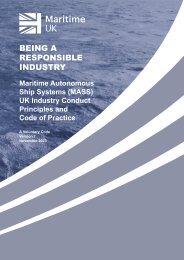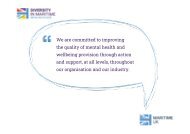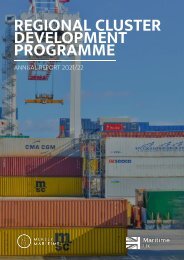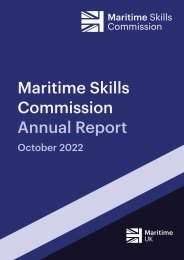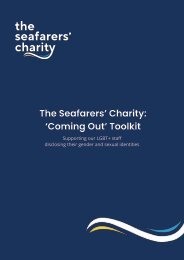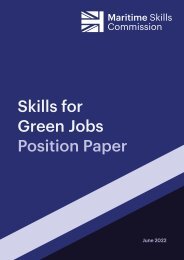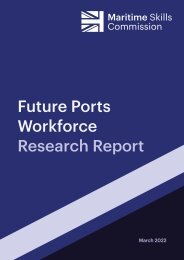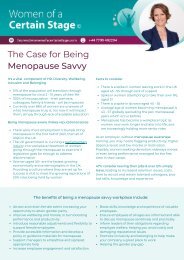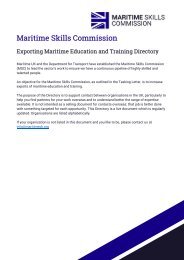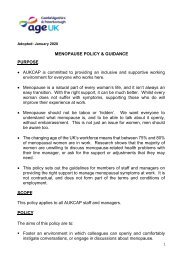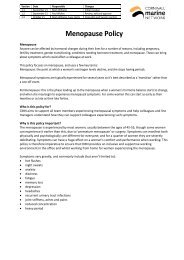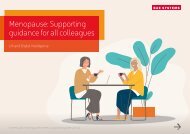code_of_practice_V3_2019
Create successful ePaper yourself
Turn your PDF publications into a flip-book with our unique Google optimized e-Paper software.
“Controller” means a person undertaking control functions appropriate for the Level <strong>of</strong> Control <strong>of</strong> the MASS. The<br />
controller may report to either a Watch Officer or the Master depending on the constitution <strong>of</strong> the control function, the<br />
MASS category and the required Level <strong>of</strong> Control.<br />
“Coxswain” refers to any person controlling the MASS, either remotely (depending on the category <strong>of</strong> control applicable<br />
to the MASS during an operation) or to a person controlling the MASS from an onboard control station during any period<br />
<strong>of</strong> operation under direct manned control (e.g. pilotage).<br />
“Crew” means a person employed or engaged in any capacity on-board a ship on the business <strong>of</strong> the ship or any person<br />
engaged in the direct control and operation <strong>of</strong> the ship from a remote location.<br />
“Daylight” means from civil twilight before sunrise until civil twilight after sunset.<br />
“Decked vessel” means a MASS with a continuous watertight weather deck which extends from stem to stern and has<br />
positive freeboard throughout, in any condition <strong>of</strong> loading <strong>of</strong> the MASS. Where an appropriate ISO standard is used, the<br />
definition should be taken from those standards as applicable.<br />
“Degrees <strong>of</strong> Autonomy”. The following Degrees <strong>of</strong> Autonomy have been established by the International Maritime<br />
Organization for their Regulatory Scoping Exercise in IMO MSC Circular 1604:<br />
Table 1-2: Degrees <strong>of</strong> Autonomy (IMO)<br />
1<br />
2<br />
3<br />
4<br />
Ship with automated processes and decision support.<br />
Seafarers are on board to operate and control shipboard systems and functions. Some operations may<br />
be automated and at times be unsupervised but with seafarers on board ready to take control.<br />
Remotely controlled ship with seafarers on board.<br />
The ship is controlled and operated from another location. Seafarers are available on board to take<br />
control and to operate the shipboard systems and functions.<br />
Remotely controlled ship without seafarers on board.<br />
The ship is controlled and operated from another location. There are no seafarers on board.<br />
Fully autonomous ship.<br />
The operating system <strong>of</strong> the ship is able to make decisions and determine actions by itself.<br />
N.B. The above list does not represent a hierarchic order. It should be noted that MASS could be operating at one or<br />
more degrees <strong>of</strong> autonomy during the duration <strong>of</strong> a single voyage.<br />
“Design Category” means a description <strong>of</strong> the wind and sea conditions for which a MASS is considered suitable under<br />
the EC Directive 94/25/EC <strong>of</strong> 16th June 1994, as amended by 2003/44/EC, on the approximation <strong>of</strong> the laws, regulations<br />
and administrative provisions <strong>of</strong> the Member States relating to recreational craft and used for the application <strong>of</strong> relevant<br />
ISO and CEN standards. See Table 1-3 below:<br />
Table 1-3: Design Categories<br />
Design category Wind force (Beaufort scale) Significant wave height (HS, metres)<br />
A - 'Ocean' Exceeding 8 Exceeding 4<br />
B - ‘Offshore’ Up to, and including, 8 Up to, and including, 4<br />
C - ‘Inshore’ Up to, and including, 6 Up to, and including, 2<br />
D - ‘Sheltered waters’ Up to, and including, 4 Up to, and including, 0.5<br />
MASS UK Industry Conduct Principles and Code <strong>of</strong> Practice Version 3<br />
19




